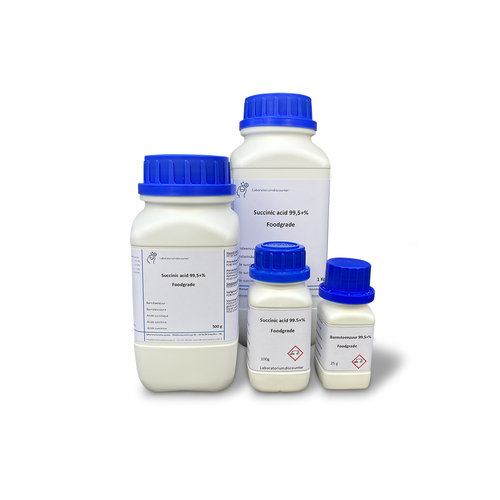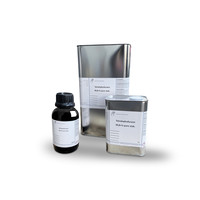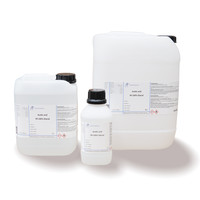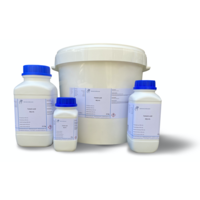You have no items in your shopping cart
Succinic acid 99,5+%, foodgrade
- Buy 2 and save 5%
- Buy 6 and save 10%
What is Succinic Acid?
Succinic acid, also succinic acid or butanedioic acid, E 363, is a colorless, crystalline aliphatic dicarboxylic acid. The crystals are easily soluble in boiling water.
What is Succinic Acid used for?
-Use in the food sector
Succinic acid is approved in the EU as food additive number E 363 and, due to its slightly sour and at the same time slightly salty taste, serves as a flavor enhancer for desserts, dry soups and powdered drinks. Various salts of succinic acid (Fe, Mg, Ca, K) are used as table salt substitutes in diet foods. Due to the body's own production and metabolism of succinic acid, the use of succinic acid as a food additive is considered harmless.
During alcoholic fermentation and when the wine is later aged in containers such as the wooden barrel or the stainless steel container, succinic and acetic, butyric and lactic acids are also produced in addition to the wine's central acids (tartaric, malic and citric). Succinic acid mainly results from carbonic acid maceration and has a slightly bitter and salty taste; esterification to monomethyl succinate gives a slightly fruity component to the wine.
-Technical use
Succinic acid is a platform chemical with an annual requirement of currently about 15,000 tons. It is used for the production of polyester and alkyd resins. Some succinates esterified with polyalcohols are used as solvents and plasticizers for plastics and waxes, and other esters are used in the production of perfumes. In the form of sulfosuccinic acid esters, succinic acid is also used as an important surfactant group, but these are usually made on the basis of maleic acid.
Succinic acid is also one of the central hopes of industrial biotechnology as a platform chemical and hence as a raw material for various industrially produced chemicals and polymers. It can be used as starting material for biotechnological production, e.g. of 1,4-butanediol (BDO), 1,4-butanediamine, tetrahydrofuran (THF), N-methyl-2-pyrrolidone (NMP), γ-butyrolactam, γ-butyrolactone (GBL) and some other products. Succinic acid is particularly interesting as a biotechnologically manufactured product and a market potential of hundreds of thousands of tons is predicted as the basis for various products in the chemical and pharmaceutical industries, as well as for biobased plastics such as polyamides (PA), polyesters and copolyesters and polyesteramides.
Together with other representatives of C4-dicarboxylic acids such as fumaric acid and malic acid, succinic acid was therefore identified in 2004 by the US Department of Energy as one of twelve platform chemicals with special biotechnology production potential. In a 2010 review of the list, succinic acid is one of the ten products with the highest potential in biorefinery technology.
Buy high quality succinic acid?
The Succinic acid from Laboratory Discounter is of very high purity and also food grade. It can therefore be used as a food additive. So if you need succinic acid, you can order it for a friendly price at Laboratoriumdiscounter.nl! Delivered quickly!
Technical data
Amber acid, Butanedioic acid
Empirical formula C4H6O4
Molar mass (M) 118.09 g/mol
Density (D) 1.564 g/cm³
Boiling point (bp) 235 °C
Flash point (flp) 206 °C
Melting point (mp) 191°C
WCK 1
CAS no. [110-15-6]
EC-No. 203-740-4
$$$$$
Hazard statements
H318 Causes serious eye damage
Safety recommendations
Precautions - prevention
P280 Wear protective gloves / eye protection.
Precautions - response
P305 + P351 + P338 IF IN EYES: Rinse cautiously with water for a long period of time
amount of minutes; remove contact lenses, if possible; keep rinsing.
P310 Immediately call a POISON CENTER / doctor.

%%%%%

















